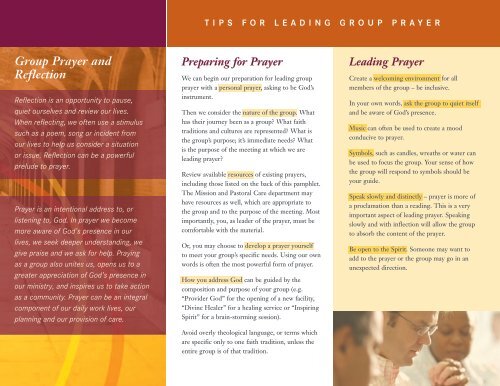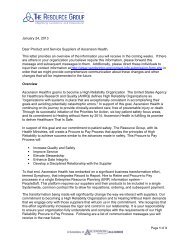Leading Prayer - Ascension Health
Leading Prayer - Ascension Health
Leading Prayer - Ascension Health
Create successful ePaper yourself
Turn your PDF publications into a flip-book with our unique Google optimized e-Paper software.
T I P S F O R L E A D I N G G R O U P P R A Y E R<br />
Group <strong>Prayer</strong> and<br />
Reflection<br />
Reflection is an opportunity to pause,<br />
quiet ourselves and review our lives.<br />
When reflecting, we often use a stimulus<br />
such as a poem, song or incident from<br />
our lives to help us consider a situation<br />
or issue. Reflection can be a powerful<br />
prelude to prayer.<br />
<strong>Prayer</strong> is an intentional address to, or<br />
listening to, God. In prayer we become<br />
more aware of God’s presence in our<br />
lives, we seek deeper understanding, we<br />
give praise and we ask for help. Praying<br />
as a group also unites us, opens us to a<br />
greater appreciation of God’s presence in<br />
our ministry, and inspires us to take action<br />
as a community. <strong>Prayer</strong> can be an integral<br />
component of our daily work lives, our<br />
planning and our provision of care.<br />
Preparing for <strong>Prayer</strong><br />
We can begin our preparation for leading group<br />
prayer with a personal prayer, asking to be God’s<br />
instrument.<br />
Then we consider the nature of the group. What<br />
has their journey been as a group What faith<br />
traditions and cultures are represented What is<br />
the group’s purpose; it’s immediate needs What<br />
is the purpose of the meeting at which we are<br />
leading prayer<br />
Review available resources of existing prayers,<br />
including those listed on the back of this pamphlet.<br />
The Mission and Pastoral Care department may<br />
have resources as well, which are appropriate to<br />
the group and to the purpose of the meeting. Most<br />
importantly, you, as leader of the prayer, must be<br />
comfortable with the material.<br />
Or, you may choose to develop a prayer yourself<br />
to meet your group’s specific needs. Using our own<br />
words is often the most powerful form of prayer.<br />
How you address God can be guided by the<br />
composition and purpose of your group (e.g.<br />
“Provider God” for the opening of a new facility,<br />
“Divine Healer” for a healing service or “Inspiring<br />
Spirit” for a brain-storming session).<br />
Avoid overly theological language, or terms which<br />
are specific only to one faith tradition, unless the<br />
entire group is of that tradition.<br />
<strong>Leading</strong> <strong>Prayer</strong><br />
Create a welcoming environment for all<br />
members of the group – be inclusive.<br />
In your own words, ask the group to quiet itself<br />
and be aware of God’s presence.<br />
Music can often be used to create a mood<br />
conducive to prayer.<br />
Symbols, such as candles, wreaths or water can<br />
be used to focus the group. Your sense of how<br />
the group will respond to symbols should be<br />
your guide.<br />
Speak slowly and distinctly – prayer is more of<br />
a proclamation than a reading. This is a very<br />
important aspect of leading prayer. Speaking<br />
slowly and with inflection will allow the group<br />
to absorb the content of the prayer.<br />
Be open to the Spirit. Someone may want to<br />
add to the prayer or the group may go in an<br />
unexpected direction.








